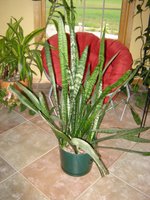Common Name:Madagascar Dragon Tree
Scientific Name: Dracaena marginata
Lighting: Moderate to Low
Watering: Moderate
The Madagascar Dragon Tree is to me one of the most popular houseplants, yet one of the hardest to identify. I looked through many houseplant books before actually finding the name of this particular Dracaena. Needless to say, this is a great houseplant and one of my favorites. Long, narrow, spike like foliage characterize this plant. Foliage is usually green with a red outline, thus giving the houseplant its drama.
The Madagascar Dragon Tree is fairly easy to care for. The greatest thing I like about the Madagascar Dragon Tree is that it allows you to create your own look with it. As you can see from mine, I just let them go at will. However you can brace your stalks up, twist them or create your own attraction with them.
The Madagascar Dragon Tree requires moderate to low light levels. This Dracaena can usually withstand lower light levels than some of the other Dracaena's. As with many Dracaena varieties, if the dramatic coloring or variegation on the foliage begins to fade, the plant may not be receiving enough light.
This houseplant prefers to have moderate water levels. So keep the soil fairly moist at all times. Dracaena's are native to the African jungles, so they do require higher humidity levels. If the tips of the foliage begin to brown, it may be a sign that there is not enough humidity in the air. In the winter, simply running a humidifier may be enough to supplement their high humidity requirements. Otherwise you can also give your plant a nice daily misting instead.
Keep in mind, this houseplant sheds its bottom foliage frequently. This does not mean you are doing anything wrong in terms of caring for it. Just as the plant grows the bottom leaves shed.






